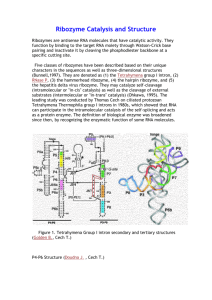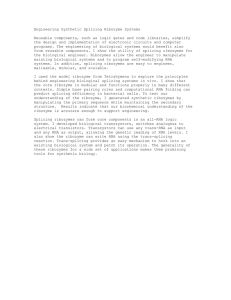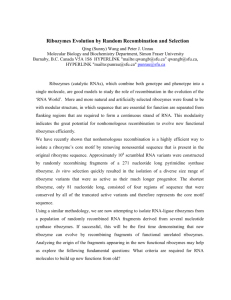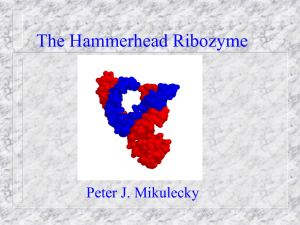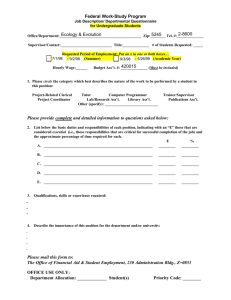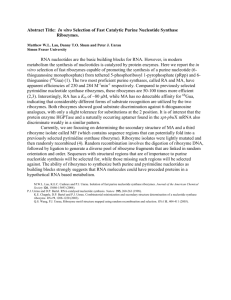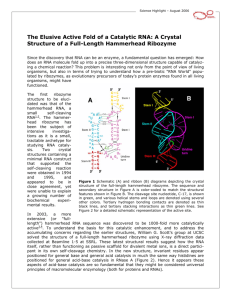The true peptidyl transferase reaction A2451 forms hydrogen-bonding
advertisement
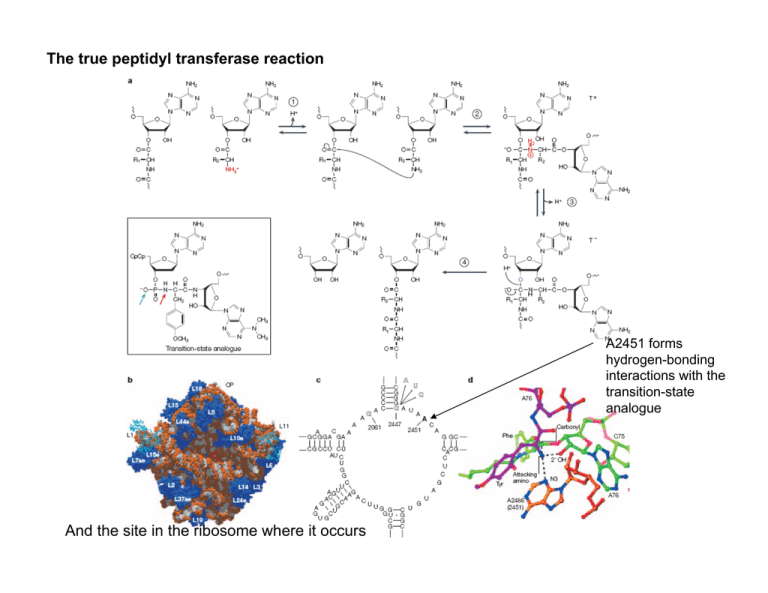
The true peptidyl transferase reaction A2451 forms hydrogen-bonding interactions with the transition-state analogue And the site in the ribosome where it occurs What is a ribozyme? The ribosome is a ribozyme; the spliceosome might be a ribozyme; RNase P is a ribozyme; and then there are small RNAs that cleave themselves that are also ribozymes. Five nucleolytic ribozymes Hairpin Ribozyme glmS Ribozyme-riboswitch Residues thought to be part of general acid/base catalysis are green/red. Scissile phosphate and 2’OH are magenta. Substrates in light blue. Hammerhead Ribozyme Hepatitis Delta Virus (HDV) Ribozyme In RNase A, the unprotonated Histidine 12 acts as a general base catalyst, extracting the H from the 2′ OH, creating a reactive Oxygen that attacks the phosphate PO4- and produces a 2′,3′ cyclic phosphate. The protonated Histidine 119 acts as a general acid and donates its H to the 5′ OCH2 leaving group. The ammonium group of Lys41 stabilizes the excess negative charge of the trigonal bipyramidal oxyphosphorane transition-state. Hairpin, hammerhead, and glmS ribozymes use the same acid/base chemistry. Where are the acid and the base? History of the Hammerhead Ribozyme. The Hammerhead can be removed from the viral genome and studied on its own. Uhlenbeck [Nature 1987 328:596] showed that it could be engineered to become a true enzyme. Cleavage site Cleavage rate increases until 50 °C, then decreases. Why? (except here) The original HH lacked stabilizing tertiary interactions. Proposed mechanism for acid/base catalysis in the hammerhead self-cleavage reaction. G12 aromatic N hydrogen bonds to the nucleophilic 2′-OH. G12 is invariant in HH ribozymes, where it serves as the general base in the cleavage reaction. The ribose 2′ OH of G8 makes a hydrogen bond to the 5′-oxo leaving group (it acts as the general acid). A schematic pathway of the hammerhead reaction illustrates both how a conformational transition positions the active site and how it might allow for the reverse ligation reaction. In the inactive, uncleaved state, a mixture of structures could be present; an even more heterogeneous mixture could be present in the inactive cleaved state. If the RNA persists for some time (how long?) in its active cleaved state, it could re-ligate the product since this is a reversible transesterification reaction. If the tertiary interaction is too strong, then ligation would also be favored. If the product:enzyme helix is too long, product release would be dis-favored and so lead to ligation. This is a dynamic process! Use ensemble measurements to look at the relative orientation of the arms of the small hammerhead (by lengthening the duplexes) Mg2+ dependence of the cleavage rate Mean distance and full width half maximum (fwhm) of the arms as a function of [Mg2+] Long-range interactions control the rate of cleavage. Mutations (red) disrupt tertiary contacts that reduce the cleavage rate via destabilizing the structure around the scissile CpG. Discontinuous Hammerhead ribozymes have the potential to control gene expression Martick et al., 2008 Nature 454, 899-902 In the hairpin (A), hammerhead (B), and glmS (C) ribozymes, the substrate is bound as part of a deformed helix that docks with other structures in the enzyme. The backbone is stretched to align it with residues that cleave it. In the hairpin (A), G8 and A38 play the part of the histidines in RNase A: G8 is the base (pKa = 9.0), and A38 the acid (pKa=5.0). A9 is in the position of Lys41 where the exocyclic amines of A9 and A38 provide electrostatic stabilization of the transition state. The Hairpin Ribozyme was discovered in a viroid RNA where it undergoes selfcleavage to produce a single copy of the RNA strand. Test the chemistry of cleavage by NAIM: a modified nucleotide with a phosphorothioate linkage. A38 cannot serve as the general acid when it is replaced by 2F-A or n8A, providing chemical evidence (in contrast to crystal evidence) that it functions like a histidine in the cleavage/ligation reaction. Dynamics of the hairpin ribozyme Engineer a three-piece RNA. Tether one strand to glass via biotin/streptavidin. On one end of the enzyme strand, add a donor and on the other end an acceptor FRET pair. Single Molecule study of the Hairpin Ribozyme. dA38 accelerates undocking, since there is a loss of a hydrogen bond. Make mutants in the tertiary interaction and see what happens to cleavage and docking. S3 is a 3-carbon propyl linker that replaces the base. Cleavage activity depends on rates of docking and undocking. The energetics of docking has contributions from distal parts of the structure away from the active site. The Hepatitis Delta Virus ribozyme requires Mg2+ for cleavage. C75 is particularly interesting. It serves as the general acid catalyst in the cleavage reaction. In the crystal structure of the HDV ribozyme in its postcleavage state, C75 is proposed to make a hydrogen bond between its N3 atom and the protonated leaving group, the 5′-hydroxyl of G1. This conformation suggested that C75 might be protonated in the reactant state, donate its proton to the 5′-O leaving group, and thereby serve as a general acid in the cleavage reaction. Removing the C75 base (creating an abasic site) inactivates HDV, but it can be rescued by addition of exogenous imidazole! Another way to look at motion (local motion) of the HDV active site is to use MD simulation*. In C75+/Mgrev C75 is protonated and the crystallographically located Mg2+ ion is included in the starting structure (it is thought to act as a Lewis acid). In C75+/noMg, the Mg is removed before equilibration. In C75°/Mgrev, C75 is deprotonated and Mg is included in the starting structure. The conclusion: Even in these short trajectories, without the protonated C75, the active site is not stable. In particular, the interaction between C75(N4) and the C22 phosphate oxygen is not maintained. *AMBER99, TIP3P. Hammes-Schiffer group with Bevilacqua Conclusion: These are small ribozymes, but they have evolved different global structures and sequences. In particular, three of the four use the same catalytic mechanism in different active sites. The chemical contexts of the active sites allows bases and riboses to act as general acids/bases, which involves local changes of the pKa. The structures flex: the active sites are in junction regions that are formed by docking of duplex regions through tertiary interactions. Docking is not stable, so the conformations fluctuate between an open inactive form and a closed active form. In two of the ribozymes, the reactions can go forward and backward (cleavage and ligation), since product release can be delayed by salt and temperature. Hammerhead ribozymes appear in all kingdoms in unexpected places!
